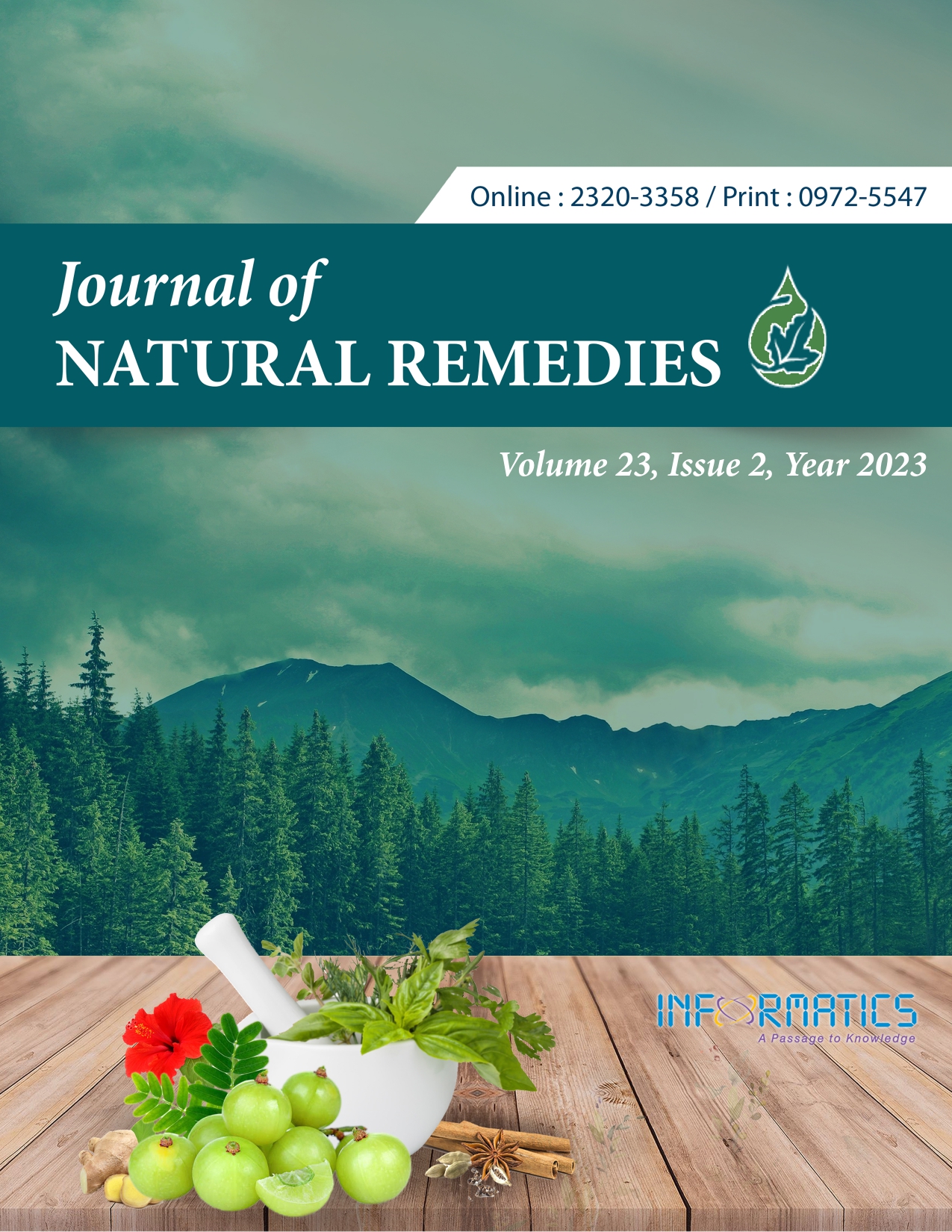Ayurveda Treatment Protocol in the Management of Relapse of Palmo-Plantar Pustulosis (PPP) - A Case Report
DOI:
https://doi.org/10.18311/jnr/2023/31888Keywords:
Ayurveda, Case Report, Palmo-Plantar Pustulosis, Purgation Therapy, RelapseAbstract
Background: Palmo-Plantar Pustulosis (PPP) is one of the debilitative skin disorders having a prevalence of 0.050 to 0.12 % worldwide, which is hallmarked by sharply demarcated erythematous pustular lesions over the body. Modern treatment provides certain moisturizers, topical steroids, light therapy, and systemic therapies in the long run, but recurrent crops of pustular lesions are the main problem. Here a case of PPP treated with Ayurvedic protocol is discussed. A 65-year old female patient complained of blackish-red pustular desquamative lesions over the upper and lower limb associated with occasional oozing after itching with extreme hardness and rough texture over the affected area for three years. The ailment was diagnosed as kitibha (a type of psoriasis), and the treatment was organized accordingly. The patient received continuous virechana (purgative therapy) for three months at a rate of six days per month, followed by pathya (wholesome food), topical application, and internal medications. Auspitz signs and PASI (Psoriasis Area and Severity Index) assessment, along with symptomatic improvement in signs and symptoms, were used to quantify the outcome of the disease. After receiving the initial bowel cleansing medications such as Patolakaturohinyadi Kashaya, Saribadyasava, and Manibhadragula, the patient claimed complete recovery from the acute phase. The second phase was followed by continuous virechana (purgation therapy) for three months at a rate of six days per month, which showed no signs of relapse for three consecutive months in the affected areas. Even though PPP is incredibly challenging to treat, shodhana (purificatory therapy) for six consecutive months can potentially prevent relapse. This opens up the future scope for structured clinical trials in the treatment of disease.
Downloads
Metrics
Downloads
Published
How to Cite
Issue
Section
License
Copyright (c) 2023 James Chacko, B. Varshanath, Delvin T. Robin, Preethi Mohan (Author)

This work is licensed under a Creative Commons Attribution 4.0 International License.
Accepted 2023-04-28
Published 2023-06-13
References
Brunasso AM, Massone C. Recent advances in Palmoplantar pustulosis. Faculty Reviews. 2021; 10. https://doi.org/10.12703/r/10-62 DOI: https://doi.org/10.12703/r/10-62
Acharya Agnivesha, Charaka Samhita, Chikitsa sthan 7/22, English translation by Sharma RK and Bhagwan Dash, Reprint edition, Varanasi: Chowkhamba Sanskrit Series Office; 2014. p. 557.
Ashtanga Hrudayam, Nidana sthan 14/22. Kaviraaj Atridev Gupta, Ashtanghrudayam with Vidyotini Hindi Commentary, Chaukhamba Sanskrit Sansthan, 14th ed; p. 44.
Acharya Bhela, Bhela Samhita, Chikitsa sthan 6/25, Krishnamoorthy KH, Reprint ed, Varanasi: Choukhambha Viswabharati Orientalia Publishers; 2003.
Acharya Kashyapa, Kashyapa Samhita, Chikitsa sthana 9/2, prof. (km.) Tewari PV, Reprint ed, Varanasi: Choukhambha Viswabharati; 2002.
Acharya Agnivesha, Charaka Samhita, Sutra Sthan 16/20, English translation by R.K. Sharma and Bhagwan Dash, Reprint ed. Varanasi: Chowkhamba Sanskrit Series Office; 2014. p. 557.
Ashtanga Hrudayam, Chikitsa Sthan 19/96, Kaviraaj Atridev Gupta, Ashtangahrudayam with Vidyotini Hindi Commentary, Chaukhamba Sanskrit Sansthan, 14th ed; 2006. p. 44.
Acharya Vagbhata: Ashtanga Hridayam with Sarvanga Sundara commentary of Arunadatta and Ayurveda Rasayana of Hemadri, Edited by Bhisagacharya Hari Sadasiva Sastri Paradakara Sthana, Sutrasthana 15th chapter, Sloka 15; p. 235.
Govindadas, Bhaishajya Ratnavali, Chaukhamba, Samskrita, Samsthan,Varanasi, Pramehapidika adhikara 37, Shloka 22-27; 2000. p. 1196. p. 722.
Ashtanga Hridaya Vagbhata (Ed.) Pandit Hari Sadasiva Sastri Paradkar with sarvanga sundara commentary of arunadatta and Ayurveda rasayana commentary of hemadri, Published by Chaukhamba Surbharti Prakashan, Varanasi, Reprint Ed; Chikitsasthana Chapter 19, Shloka-31-32; 2010. p. 713.
Nille GC, Chaudhary AK. Potential implications of Ayurveda in Psoriasis: A clinical case study. J Ayurveda Integr Med. 2021; 12(1):172-7. https://doi.org/10.1016/j.jaim.2020.11.009
Ashtanga Hridaya Vagbhata, editor. Pandit Hari Sadasiva Sastri Paradkar with sarvanga sundara commentary of arunadatta and Ayurveda rasayana commentary of hemadri, Published by Varanasi: Chaukhamba Surbharti Prakashan. Reprint Ed; Chikitsasthana Chapter 19, Shloka-28-30; 2010. p. 713.
Acharya Agnivesha, Charaka Samhita, Chikitsa Sthan 7/39-40, English translation by Sharma RK, and Bhagwan Dash, Reprint ed. Varanasi: Chowkhamba Sanskrit Series Office; 2014. p. 557.
Nille GC, Chaudhary AK. Potential implications of Ayurveda in psoriasis: A clinical case study. Journal of Ayurveda and Integrative Medicine. 2021; 12(1):172-7. https://doi.org/10.1016/j.jaim.2020.11.009 DOI: https://doi.org/10.1016/j.jaim.2020.11.009
Sunil MA, Sunitha VS, Radhakrishnan EK, Jyothis M. Immunomodulatory activities of Acacia catechu, a traditional thirst quencher of South India. Journal of Ayurveda and Integrative Medicine. 2019; 10(3):185-91. https://doi.org/10.1016/j.jaim.2017.10.010 DOI: https://doi.org/10.1016/j.jaim.2017.10.010
Abhilesh VS, Prathibha CKB, Anandaraman PVS. Management of erythrodermic psoriasis through Ayurveda - A case report. Perm J. 2021; 25(3):1-9. https://doi.org/10.7812/TPP/20.221 DOI: https://doi.org/10.7812/TPP/20.221
Bhavaprakash Nighantu (Indian material medica), Varanasi: Chaukhamba Bharati Academy Rp Shaaka Varga. 2015: (71):673.
Aiswarya IV, Parameswaran Namboothiri K, Anandaraman PV. Effect of a multimodality Ayurveda treatment in the case of Visphota Kushta. Journal of Ayurveda and Integrative Medicine. 2019; 10(3):207-13. https://doi.org/10.1016/j.jaim.2018.06.005 DOI: https://doi.org/10.1016/j.jaim.2018.06.005

 James Chacko
James Chacko









 0.35
0.35 24
24 0.161
0.161